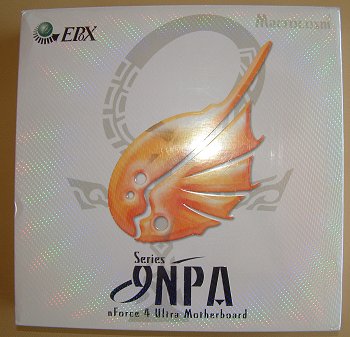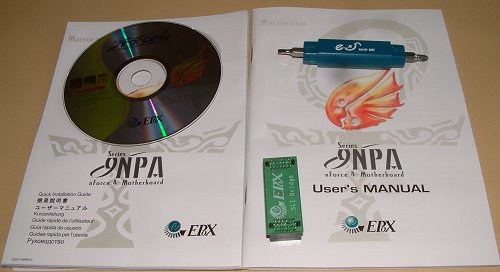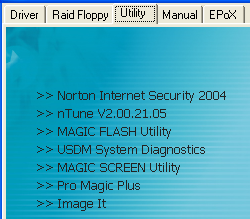Presentation and bundle

EPoX's presentation has certainly come on in the last year or so. Boring boxes have been replaced with oversized, but understated, designs. For S939 CPUs, EPoX has the 9NPA+ (~£70), the 9NPA+ Ultra (~£85), and the board in for review today, the 9NPA+ SLI (~£105). All three are based on the nForce4 chipset, although the latter two make do with the better-featured nForce4 Ultra, and, of course, the 9NPA+ SLI lets you run 2 SLI-capable NVIDIA GPUs for extra performance.

Part one of the bundle is typically EPoX. Purple-coloured, rounded IDE cables don't tickle by style buds. I suppose they're better than the regular, flat variety. Additional high-speed connectivity is taken care of by a couple of brackets. The left-hand one adds in two FireWire (1394a) ports, and the right does the same for USB 2.0. There's also a regular floppy drive cable. EPoX also adds in a couple of SATA cables and associated SATA-to-molex power adapters.

The second part of the bundle is pre-packaged in EPoX's Power Pack case. The review model was an early sample that didn't carry all of the Power Pack's regular extras. Missing from the above shot, most notably, is EPoX's Thermo Stick, a handy temperature-measuring sensor that plugs into the board and then can be attached to any component. EPoX will also bundle in a pack of mini-heatsinks, too, as shown in the 5LWA+ review.
The 9NPA+ SLI's manual is pretty good. It's easy to read and does a genuinely good job of describing each board feature, installation, and software installation. Colour photographs would be nice, though. There's also a multi-language fold-out sheet that, strangely, only discusses the 9NPA+ Ultra motherboard.

The driver/application CD contains EPoX's MAGIC FLASH utility that's designed to download appropriate BIOSes from EPoX's server and automatically flash to a newer version if available. Trying it, however, led to checksum error. The board's BIOS was flashed through the easy-to-use WinFlash utility. NVIDIA has its own system-monitoring utility, nTune, but it seemed to think that an Athlon 64 FX-53 ran at a default 2500MHz. Hmmm. EPoX's version goes under the name of USDM, and it provides a decent array of options, including fan control based on CPU temperature.
All-in-all, a decent enough bundle for a board that ships with SLI compatibility and a price tag of around £105.









